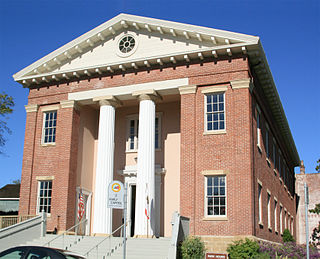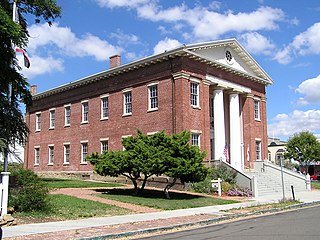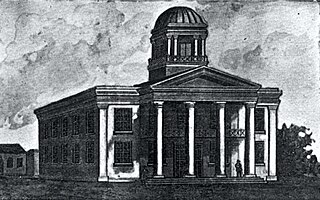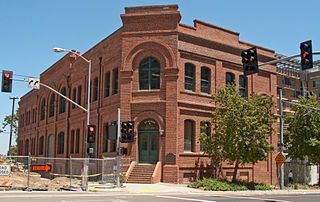
Sutter's Fort was a 19th-century agricultural and trade colony in the Mexican Alta California province. Established in 1839, the site of the fort was originally called New Helvetia by its builder John Sutter, though construction of the fort proper would not begin until 1841. The fort was the first non-indigenous community in the California Central Valley. The fort is famous for its association with the Donner Party, the California Gold Rush, and the formation of the city of Sacramento, surrounding the fort. It is notable for its proximity to the end of the California Trail and Siskiyou Trails, which it served as a waystation.

Benicia is a waterside city in Solano County, California, located in the North Bay region of the San Francisco Bay Area. It served as the capital of California for nearly thirteen months from 1853 to 1854. The population was 26,997 at the 2010 United States Census. The city is located along the north bank of the Carquinez Strait. Benicia is just east of Vallejo and across the strait from Martinez. Steve Young, elected in November 2020, is the mayor.

Benicia Capitol State Historic Park is a state park in Benicia, California, United States. The park is dedicated to California's third capitol building, where the California State Legislature convened from February 3, 1853 to February 24, 1854, when they voted to move the state capital to Sacramento. It is the only pre-Sacramento capitol that remains. The park includes the Fischer-Hanlon House, an early Benicia building that was moved to the property and converted into a home in 1858, after the legislature departed. Benicia Capitol State Historic Park just off the city's main street also includes a carriage house, workers' quarters and sculptured gardens.
Keyesville is an unincorporated community in Kern County, California. It is located 2 miles (3.2 km) west of Lake Isabella and the Kern River Valley, at an elevation of 2,848 feet (868 m). Keyesville, founded in 1854 is named for Richard M. Keyes, whose discovery of gold in 1853 started the Kern River Gold Rush. The community is currently owned by the Bureau of Land Management.

A California Historical Landmark (CHL) is a building, structure, site, or place in the U.S. state of California that has been determined to have statewide historical landmark significance.

Marshall Gold Discovery State Historic Park is a state park of California, United States, marking the discovery of gold by James W. Marshall at Sutter's Mill in 1848, sparking the California Gold Rush. The park grounds include much of the historic town of Coloma, California, which is now considered a ghost town as well as a National Historic Landmark District. The park contains thre California Historical Landmarks: a monument to commemorate James Marshall (#143), the actual spot where he first discovered gold in 1848 (#530). Established in 1942, and Coloma Road (#748),. The park now comprises 576 acres (233 ha) in El Dorado County.

The Vallejo Station was created by combining the Vallejo Ferry Terminal, the Vallejo Transit Center bus station, and a connecting multi-story parking garage and paseo. It is designed to be an inter-modal transit station in Vallejo, California. It is located in the western part of Central Vallejo.
The Western Pacific Railroad (1862–1870) was formed in 1862 to build a railroad from Sacramento, California, to the San Francisco Bay, the westernmost portion of the First transcontinental railroad. After the completion of the railroad from Sacramento to Alameda Terminal on September 6, 1869, and then the Oakland Pier on November 8, 1869, which was the Pacific coast terminus of the transcontinental railroad, the Western Pacific Railroad was absorbed in 1870 into the Central Pacific Railroad.
Lavers' Crossing is a former settlement in Kern County, California. It was located 1 mile (1.6 km) west-northwest of Glennville, at the current junction of White River and Jack Ranch roads.

The Old Masonic Hall, also known as Benicia Masonic Hall, is a historic building in Benicia, California. Constructed by Benicia Masonic Lodge No. 5 in summer 1850, on land donated by Alexander Riddell and with lumber donated by Benicia founder Robert Semple, it was the first purpose build Masonic Hall in California. It was occupied by the lodge October 14, 1850, and formally dedicated December 27, 1850.

The Sonoma Barracks is a two-story, wide-balconied, adobe building facing the central plaza of the City of Sonoma, California. It was built by order of Mariano Guadalupe Vallejo to house the Mexican soldiers that had been transferred from the Presidio of San Francisco in 1835. The Presidio Company and their commander, Vallejo, were also responsible for controlling the Native Americans living on the northern border of Mexican California.

Sacramento First Courthouse also, Former California State Capitol site, is historical site in Sacramento, California. The Courthouse was also the first and second California State Capitol. The site is California Historical Landmark No. 869, registered on January 11, 1974. At the northwest corner of 7th Street and I Street, 651 I Street, Sacramento was a building that served as California's State Capitol. The first period was January 16, 1852 to May 4, 1852 and the second period was from March 1, 1854 to May 15, 1854 with the California State Legislature third and fifth sessions. The 651 I Street building was the Sacramento County courthouse. The site of former California State Capitol - Sacramento County courthouse is now the Main Sacramento County Jail built in 1989. A California Historical marker was place at the site in 2007 by California State Parks working the Sacramento Trust for Historic Preservation.

Pioneer Telegraph Station, is historical building in Sacramento, California. The building is a California Historical Landmark No. 366 listed on October 9, 1939. From 1863 to 1868 the building housed the State Telegraph Company. From 1868 to 1915 the building housed the Union Telegraph Company. The Pioneer Telegraph Station Building is part of the Old Sacramento State Historic Park. The Pioneer Telegraph Station Building is sometimes confused with the Pony Express Terminal building, also in Old Sacramento State Historic Park.

Overton Building was a historical two-story building in Sacramento, California. The site of former Overton Building is a California Historical Landmark No. 610 listed on May 22, 1956. This site is now a Parking lot near the corner of 2nd street and J Street in Old Sacramento State Historic Park. The Overton Building was removed when the Interstate 5 freeway was build in the 1960s. The historical Western Hotel, D.O. Mills Bank and the original Sacramento Bee building were also taken down for the I-5 freeway. The Overton Building first housed a number of California state offices including: the California Governor's Office and the California Secretary of State. The building, on the lot before the Overton Building, was lost in a fire on November 2, 1852. The first California State Library was housed on the second floor from 1853 to 1856. The building was built by the bankers, Read & Company at a cost $105,000 in 1852. In the 1950s and early 1960s Overton Building was the Rialto Hotel and Rialto Cafe.

Folsom Powerhouse Station A is a historical building in Sacramento, California. The Folsom Powerhouse Station is a California Historical Landmark No. 633.2 listed on March 3, 1958. Station A was constructed by the Sacramento Electric Power and Light Company in 1894. Folsom Powerhouse Station A is located at the northeast corner of 6th and H Streets. Folsom Powerhouse Station A was the first electricity distribution site for Sacramento. The electricity came from Folsom Powerhouse, California Historical Landmark No. 633.0. The Folsom Powerhouse Station A started operates on July 13, 1895. With the power, Folsom Powerhouse Station A was able run the first overhead wire streetcar system not just Sacramento, but the nearby California Central Valley. Folsom Powerhouse Station A, outputted alternating current (AC) produced by the Folsom Powerhouse hydroelectric power station. This AC system was one of the first AC system in the United States, as at the time other systems were DC current.

Catholic Basilica foundation is a historical site in Shasta, California in Shasta County. Catholic Basilica site is a California Historical Landmark No. 483 listed on April 10, 1951. The cornerstone of Catholic Basilica was place in May 1857 by Archbishop Joseph Sadoc Alemany O.P. and the Reverend Raphael Rinaldi. The church had its begianing in 1853, when the Archbishop of San Francisco, Alemany, sent Father Florian Schwenninger to be the head of mission in Shasta County serving the miners and settlers. The first church was small wooden church built in 1853. In 1855 Father Schwenninger was transferred to Weaverville and Father Raphael Rinaldi took of duties at Shasta. Father Rinaldi started to built the new stone church in 1857, to replace the wooden church. The building did not get beyond the laying of the Foundation, that is still on the site.

Old California Oregon Road is a historical site in Anderson, California, in Shasta County. Old California Oregon Road site is California Historical Landmark No. 58 listed on December 6, 1932. The Old California Oregon Road was the main road used by pioneer travelers between the Trinity River and the northern gold mines of California and Oregon. The main part of the Old California Oregon Road ran from Portland to Sacramento.

Benicia Seminary was founded by a board of trustees in June 1852, as the Young Ladies' Seminary of Benicia in Solano County, California in the city of Benicia, California. The Benicia Seminary site is a California Historical Landmark No. 795 listed on September 6, 1964. At is peak the Young Ladies' Seminary of Beniciain had 149 students from all over Northern California. Young Ladies' Seminary of Beniciain was the Protestant Christian Junior College of its day. This was the first of this type of school in California. Mrs. S. A. Lord was the first School Principal in 1852, in 1853 Miss J. M. Hudson became Principal. In 1854, Atkins purchased the school. The Young Ladies' Seminary of Beniciain was sold to Cyrus Mills and Susan Mills in 1865 for $5,000, by Mary Atkins. Thus Benicia Seminary became Mills College. Mills College moved to Oakland, California in July 1871 by train, students, teacher and supplies. Mills College is still a private college. Mills College was granted a charter as a college by the State of California in 1885. Mary Atkins Lynch was born July 7, 1819 in Jefferson, Ohio. Mary Atkins married John Lynch (1824–1900) in 1869. Mary Lynch died September 14, 1882, at aged 63 in Benicia, California. Mary Lynch is buried at Benicia City Cemetery.

First Presbyterian Church of Benicia was founded on April 15, 1849, at a building in Benicia, California in Solano County, California. The Presbyterian Church of Benicia site is a California Historical Landmark No. 175 listed on March 6, 1935. The First Presbyterian Church of Benicia was the first Protestant church founded in California with a staff pastor. The pastor was Reverend Sylvester Woodbridge Jr., who founded the church in 1849 using a school house. Woodbridge came to California in 1848. First Presbyterian Church built a building that was dedicated on March 9, 1851. Woodbridge was the pastor till 1869, when he moved to San Francisco. The Presbyterian California Gold Rush church ended in 1875. The Church became a One-room school and most the members moved to the First Congregational Church of Benicia founded in 1865. Later the church-school building became an Episcopal Church. The Episcopal Church soon built a larger church. The 1851 church was remove and the land became Benicia City Park.
Sebastiani Vineyard and Winery also called the San Francisco Solano de Sonoma Mission Vineyard was founded in 1825 in Sonoma, California in Sonoma County, California. The Sebastiani Vineyard and Winery is a California Historical Landmark No. 739 listed on June 6, 1960. Sebastiani Vineyard and Winery was founded by the Franciscan Fathers at the Mission San Francisco Solano. The wine produced was used for Holy communion in worship church services and Holy mass. The San Francisco Solano de Sonoma Mission Vineyard was the first vineyard in Sonoma Valley. All the California Missions lost land and building in the Mexican secularization act of 1833. First Mexican Republic sold the San Francisco Solano de Sonoma Mission Vineyard to Samuele Sebastiani in 1902. Sebastiani was a young immigrant from Italy who ran the Sebastiani Vineyard and Winery with his wife Elvira. The Sebastiani Vineyard and Winery continues to be a Sebastiani family runs vineyard and winery at 394 4th Street in Sonoma.


















